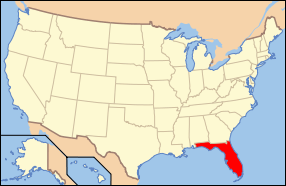Fort Foster
| Fort Foster Historic Site | |
|---|---|
|
IUCN category V (protected landscape/seascape) | |
 | |
 | |
| Location | Hillsborough County, Florida, USA |
| Nearest city | Zephyrhills, Florida |
| Coordinates | 28°8′57″N 82°13′11″W / 28.14917°N 82.21972°WCoordinates: 28°8′57″N 82°13′11″W / 28.14917°N 82.21972°W |
| Established | June 13, 1972 |
| Governing body | |
|
Fort Foster | |
  | |
| Nearest city | Zephyrhills, Florida |
| Area | 30 acres (12.1 ha) |
| Architect | Foster,Lt. Col. William,S. |
| NRHP Reference # | 72000324[1] |
| Added to NRHP | June 13, 1972 |
Fort Foster (now known as Fort Foster Historic Site) was a fort in central Florida, located 9 miles (5.6 km) south of current-day Zephyrhills in Pasco County.
Fort Foster was originally built in December 1836 under the direction of Lt. Col. William S. Foster on the site of Fort Alabama. On December 1, 1836 Colonel Foster arrived at the site with 430 men to rebuild the fort and bridge that had been destroyed months earlier. By December 19, he had erected 2 blockhouses, a large storehouse and a fort. Then on the 22nd, Col. Foster departed with 180 men, and 25 wagons with provisions and forage to resupply Fort Armstrong. The remainder of his men were tasked with completing the bridge and powder magazine.
On January 1, 1837, Col. Foster boasted in a letter to Genl. R. Jones that, "the works at "Fort Foster" on the Hillsborough River. That Fort & Bridge form one of the best and strongest field fortifications ever erected against Indians."
Fort Foster was a strategic fortification built for the protection of the bridge and with more importance on the supplies within. Fortified supply depots were continuously placed deeper into Seminole territory to allow the soldier to operate in the field while they captured the hostile Seminoles.
The armament and supplies at Fort Foster consisted as follows: A six pounder and a howitzer with at least 100 rounds of ammunition for each. Forty thousand rounds of rifle powder and bullets. Fifty thousand ball and buckshot cartridges. Fifty thousand rations of subsistence and ten thousand bushels of corn. Tools of every description as well as iron, steel, nails, cordage, & etc. required for service in the field.
Fort Foster was garrisoned from January until March 1837 by Navy Lieutenant Thomas J. Leib, 2 Midshipmen and about 50 Sailors from the USS Concord. Lt Leib was also provided with 20 artillerymen to man the six pound iron gun and twelve pound howitzer to defend the fortification and bridge.
The site was significant for skirmishes in February 1837 during the Second Seminole War, when 50 seamen from the USS Concord and 20 artillerymen resisted Seminole attacks and attempts by the hostile Seminoles to burn the bridge. That summer, the fort was abandoned because of disease among its forces.
Fort Foster was reactivated in the fall of 1837 to the summer 1838 to act as a supply post. Then it remained abandoned until 1841-1842, and again in 1849 when it only opened for short periods to meet the needs of the military when Seminole activity threatened.[2]
The fort site was added to the U.S. National Register of Historic Places on June 13, 1972. A replica of the fort was constructed at the site by the state and opened to the public in February 1980. It is owned and operated by the Florida State Park system as Fort Foster State Historic Site, a part of Hillsborough River State Park.
References
- ↑ National Park Service (2010-07-09). "National Register Information System". National Register of Historic Places. National Park Service.
- ↑ The Florida Bicentennial Trail
Gallery
 Sign explaining background
Sign explaining background


External links
- Fort Foster State Historic Site, Official Website
- Hillsborough County listings, National Register of Historic Places
- Hillsborough County listings, Florida's Office of Cultural and Historical Programs
- "Fort Foster Historic State Park", Florida Parks
- "Fort Foster State Historic Site", Wildernet
- Fort Foster, The Florida Frontiersman
| Wikimedia Commons has media related to Fort Foster. |

